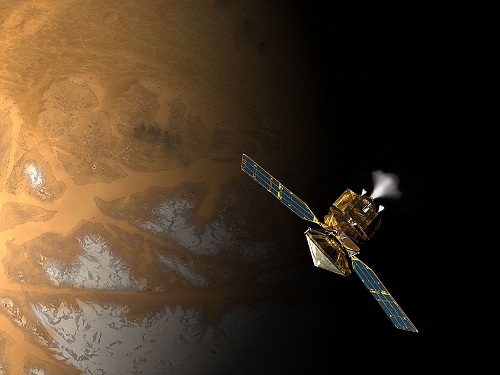![]() || A Closer Look at Mars
|| A Closer Look at Mars
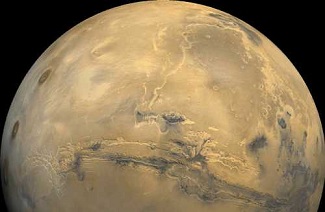
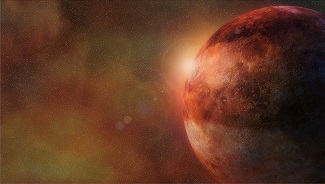
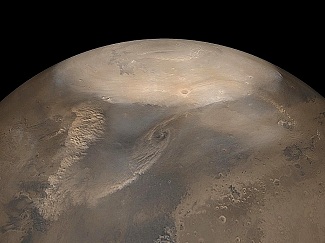
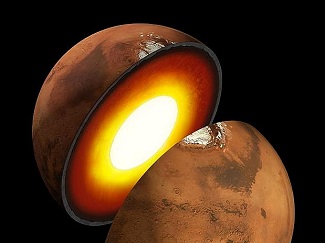
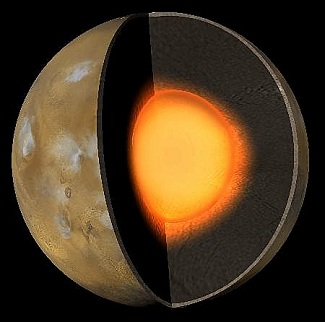
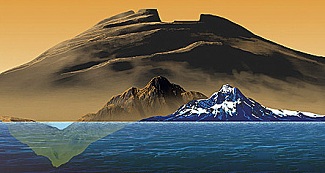 The Olympus-Mons Volcano on Mars (27 km) compared to the Highest Mountain on Venus and Earth (Mount Everest)
The Olympus-Mons Volcano on Mars (27 km) compared to the Highest Mountain on Venus and Earth (Mount Everest)
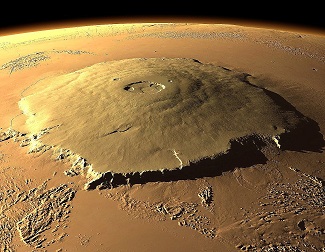 Aerial View from Space of the Olympus-Mons Giant 27 km High Volcano on Mars
Aerial View from Space of the Olympus-Mons Giant 27 km High Volcano on Mars
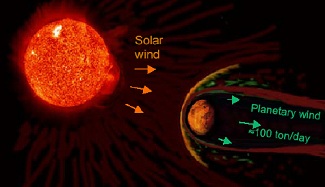
 Impression of the Curiosity Rover on Planet Mars
Impression of the Curiosity Rover on Planet Mars
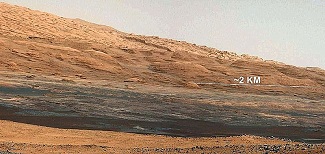 Curiosity's View of Aeolis Mons ("Mount Sharp") on August 9, 2012 EDT
Curiosity's View of Aeolis Mons ("Mount Sharp") on August 9, 2012 EDT
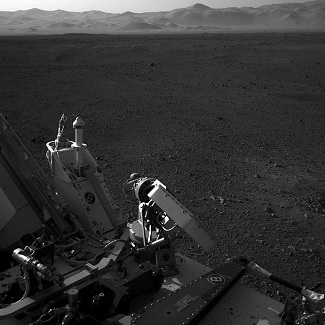 Curiosity's Black and White View of the Martian Landscape, showing the rim of the Gale Crater in the background, August 2012
Curiosity's Black and White View of the Martian Landscape, showing the rim of the Gale Crater in the background, August 2012
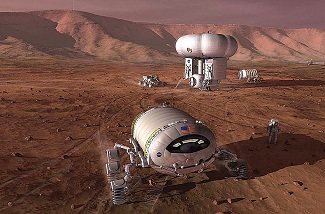 NASA Artist Impression of a Future Mars Station
NASA Artist Impression of a Future Mars Station
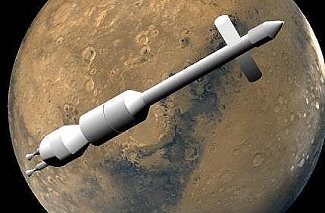 Exploration of Mars will Continue in Decades to come
Exploration of Mars will Continue in Decades to come
Mars
Mars is the fourth Planet from the Sun and the Second Smallest Planet in the Solar System

Mars is the fourth Planet from the Sun and the Second Smallest Planet in the Solar System

Facts about Mars:
Equatorial Circumference: 21,296.9 km
Distance from Sun: 227,900,000 km (1.524 times that of Earth)
Orbital Period (Around the Sun): 687 days
Average Orbital Speed (Around the Sun): 24.077 km/s
Rotation Period about Axis:24.6 hrs
Mean Density: 33.9335 × ±0.0004 g/cm³
Mass:6.4185 ×— 10²³ kg (0.107 × Earths)
Mars Gravity: 38% of Earths
History, Composition - Structure & Characteristics of Mars
History:
Mars is often described as the "Red Planet", as the Iron Oxide prevalent on its Surface gives it a Reddish Appearance.
Past Explorations of Mars have proven that the Planet had a Magnetic Field Billions of Years ago along with Active Tectonic Plate Action.
It also revealed the possibility of a Huge Impact Crater. The Suspected Crater is thought to be 10,600 km by 8,500 km. That seems to infer an Impactor the size of Pluto hitting the Surface about 4 Billion Years ago during the Late Bombardment Period of the Solar System.
Internal Structure:
Mars Composition is similar to Earth in its Basic Composition. It has a Core that is Mainly Iron and Sulfur, wrapped in a Mantle that is Silicates, all of which is cocooned by a Crust that is made of Basalt and just enough Iron Oxide to give the Planet it Characteristic Reddish Hue. This Uniquely Red Global Surface of Mars is marked by many interesting Features - some like those on the Earth and others Strangely Different. The Reddish Color is caused by Rust (Iron Oxide) in the Soil.
Some of these Features are; Volcanoes, Canyon Systems, River Beds, Cratered Terrain and Dune Fields. Of these Features, the most Interesting includes the Apparently Dead Volcano Olympus Mons, which rises 27 km (approx 3 times Mount Everest) above the Surrounding Plains and is the Highest known Peak in the Solar System.
The Crust is probably Largely made of the Volcanic Rock Basalt, which is also common in the Crusts of the Earth and the Moon.
Mars likely has a Solid Core composed of Iron, Nickel, and Sulfur. The low Density of Mars suggested that Mars' Core must contain considerably less Iron (in comparison to the overall mass of the planet) than the other Terrestrial Planets.
The Martian Core is about 3,000 and 4,000 kilometers in Diameter, its Mantle is about 5,400 to 7,200 kilometers Wide and its Crust is about 50 kilometers thick.
Details of the Internal Composition of Mars
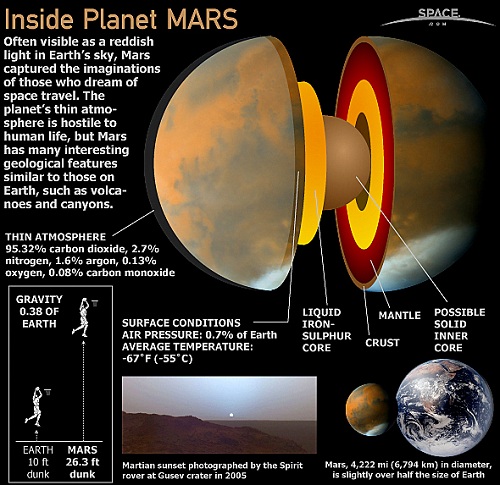
Climate:
Mars is much Colder than Earth, in Large Part due to its Greater Distance from the Sun.
The Average Temperature is about minus 60° C, although they can vary from minus 125° C near the Poles during the Winter to as much as 20° C at Mid-Day near the Equator.
The Carbon-Dioxide-Rich Atmosphere of Mars is also roughly 100 times Less Dense than Earth's on Average, but it is nevertheless thick enough to Support Weather, Clouds and Winds.
Many Theories have been put forward to Explain how Mars changed from being a Warm, Wet Planet to a Cold, Dry one.
It is Estimated that a Volume of Water Equivalent to a Planet-Wide Ocean with a Depth of between 14 and 34 Metres could have Escaped from the Red Planet during the past 3.5 Billion Years.
Unlike the Earth, Mars does not have a Magnetic Shield to Protect it from the Solar Wind, so Particles from the Sun may have played a Crucial Role in shaping the Martian Atmosphere.
The Density of the Atmosphere varies Seasonally, as Winter forces Carbon Dioxide to freeze out of the Martian Air.
The Exploration of Mars
Robot Spacecraft began Observing Mars in the 1960s, with the United States Launching Mariner 4 following a successful Fly-By of Mars in 1965.
In 1971, Mariner 9 Orbited Mars, mapping about 80 Percent of the Planet and Discovering its Volcanoes and Canyons.
In the Years to follow, both the U.S and the Soviet Union Launched numerous Mars Missions, Including for the U.S the Viking, Pathfinder and Orbiter Programs.
Every two Years, Mars and Earth reach their Closest Point, called "Opposition", when Mars can be as 'close' as 55,000,000 km from Earth. During this time, Space Agencies take Advantage of this Orbital Alignment to send Spacecraft to the Red Planet.
In 2003, the Closest Mars had passed to Earth in nearly 60,000 Years, NASA launched two Rovers, nicknamed Spirit and Opportunity, which Explored Different Regions of the Martian Surface, and both found Signs that Water once flowed on the Planet's Surface.
Number of Active Missions at Mars:
2012 - 5 | 2011 - 4 | 2010 - 5 | | 2009 - 5 | 2008 - 6 | 2007 - 5 | 2006 - 6
Mars Missions (Current & Future):
The NASA Mars Science Laboratory Mission with its Rover named Curiosity, was Launched on November 26, 2011.
The Rover carries Instruments Designed to look for Past or Present Conditions relevant to the Past or Present Habitability of Mars. The Curiosity Rover Landed on Mars on Aeolis Palus in Gale Crater on August 6, 2012 at 05:14:39 UTC.
Since then, the Curiosity Rover has made its First Major Science Discovery, and it's one for the ages. Recently, Scientists announced that Water - Fast Running and Relatively Deep - once Coursed over Mars's now Bone-Dry Surface, a Finding Based on the Presence of Rounded Pebbles and Gravel near the Rover's Landing Site in Gale Crater. What's more, the Researchers Estimate that the Water was Present for Thousands to Millions of Years.
Manned Mars Missions
Many People have Long Advocated a Manned Mission to Mars as the next Logical Step for a Manned Space Program after Lunar Exploration. The Main Issues with Manned Missions to Mars are to do with the Possibility of Life on the Surface of Mars, either already Existing, or that Existed there in the Past, and its Possible Habitability for Modern Earth Life. Mars is one of the few Places in our Solar System where "Life As We Know It" may be able to Survive. If Life Exists on Mars, a Manned Mission could Contaminate it by Introducing Earthly Microbes, so Robotic Exploration would be Preferable.
Obstacles in Manned Missions to Mars are:
Radiation: Deep space is filled with Protons from Solar Flares, Gamma Rays from Newborn Black Holes, and Cosmic Rays from Exploding Stars causing a Very High Radiation Dose for Astronauts.
A 20 min Communication Lag: It can take Almost 20 minutes to Send Commands to Mars, and then another 20 minutes before a Response is Received, a major hazard in case of Emergencies.
Isolation: A Round Trip between Earth and Mars will take Two Years or more. Astronauts will spend those Two Years in a Confined Environment.
Nevertheless, in 2010, a Bill was Signed in the United States Authorizing Manned Missions to an Asteroid in 2025 and to the planet Mars by the 2030s......
Another Mars Exploration is about to begin...
